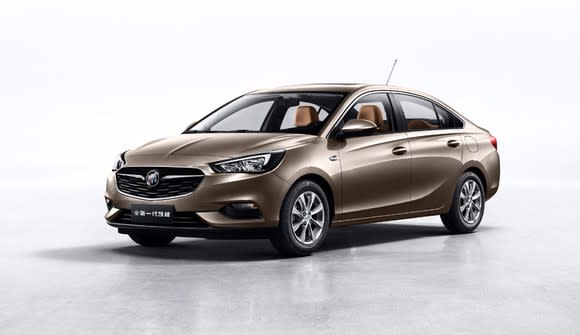What Hindered General Motors in China During the Second Quarter?
It's no secret that General Motors (NYSE: GM) has been thriving in China in recent years, and more recently driving a wider sales gap between its crosstown rival, Ford Motor Company (NYSE: F), in the region. However, the company seemed to hit a speed bump when sales during the second quarter posted a meager 0.7% increase compared to the prior year. Fortunately, its 8% gain during the first quarter helped salvage a 4.4% gain during the first half of 2018 -- but what held GM back during the second quarter, and will it rebound?
The breakdown
The biggest surprise in GM's second-quarter China data was easily Buick, with a 16.2% year-over-year decline to 230,454 units. Not only was that a significant drop, but Buick was the only brand out of five under GM's umbrella in China to post a decline. Buick is a cornerstone of the automaker's success in China. It was GM's best-selling brand in the region last year, and it helped drive GM's 2017 China sales to top 4 million for the first time. Wuling, GM's best-selling brand in the region through the first six months of 2018 (thanks to Buick's speed bump), also had a slow second quarter, with a modest 3.1% gain to 248,297 units, and it remains 5.5% lower year to date.
So which brands picked up the slack to pull off the slight gain during the second quarter? Chevrolet helped offset Buick with a strong 22.3% gain to nearly 132,000 units, and Cadillac jumped 19% to 48,712 units. Chevrolet and Cadillac have the strongest year-to-date performances under GM's brands, with 28.2% and 29.2% gains, respectively. Baojun, established in 2010, has also done a phenomenal job as a cheaper alternative to existing GM brands in China; it posted a 6% gain to nearly top 200,000 units and is up a stronger 13.2% year to date.

The classic Excelle returned to Buick's China lineup on June 22, 2018. Image source: General Motors.
Management didn't give any insight into why Buick hit a speed bump during the second quarter, but there is some hope for a second-half rebound. In late June, GM launched an all-new model of the classic Excelle, historically a strong-selling nameplate, which should boost the brand's presence in the compact sedan market and potentially boost Buick sales in China throughout the third and fourth quarters.
It could be worse
GM's 0.7% increase in second-quarter sales might not jump off the paper, but it could certainly be worse: Just ask its crosstown rival. To be fair, it was bound to be a rough year for Ford as it endures a period with fewer new models in its portfolio -- a trend that won't reverse until a batch of new models hits the showrooms next year. Ford's June sales in China hit more than a speed bump; with a 38% decline, sales fell off a cliff. Its sales in China dropped 25% to 400,443 units during the first half of the year, seemingly miles behind GM's 1.84 million units.
Here's the kicker for investors in either automaker: GM has a slight edge at a time when things could get much worse for Ford. That's because as trade tensions heat up, Ford has little to no pricing power on its older vehicle lineup and can't afford to raise prices to cover any possible new tariffs affecting imported vehicles, for fear of sending sales spiraling even further. GM, on the other hand, has a little more wiggle room with a better-selling and fresher lineup. Furthermore, GM's Cadillac brand is blossoming in China, and it produces the luxury vehicles locally to help protect itself from import duties. Meanwhile, Ford's Lincoln brand is threatened until it begins some local production in late 2019, and about half of the company's 80,000 vehicles sent from North America to China last year were Lincoln products. These luxury sales are high-margin and very important for automakers to improve profitability in a region currently less lucrative than North America.
GM struggled in China during the second quarter with its two best-selling brands, but it can stoke growth as it launches 10 new or refreshed models in the country by year's end -- and these will be models in popular luxury and SUV segments. While its second-quarter sales aren't eye-popping, GM has positioned itself far better for success in China than its Detroit counterpart. At a time when new-vehicle sales are slowing in the U.S., China remains the best volume growth story automakers can offer investors, and it's a topic you'll want to stay on top of as trade threats heat up.
More From The Motley Fool
Daniel Miller owns shares of Ford and General Motors. The Motley Fool recommends Ford. The Motley Fool has a disclosure policy.

 Yahoo Finance
Yahoo Finance 